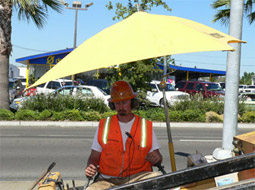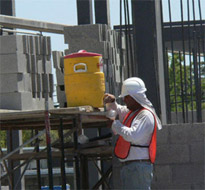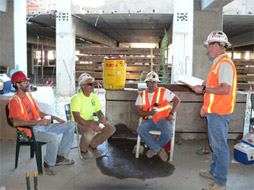
Heat Illness Prevention
 As trainers of your students and young workers, you are responsible for educating them on workplace health and safety including (but not limited to): safe work practices, worker's rights, the importance of learning in safety meetings and other trainings, and complying with rules and regulations. To reduce the risk of injury and increase productivity, see the information below:
As trainers of your students and young workers, you are responsible for educating them on workplace health and safety including (but not limited to): safe work practices, worker's rights, the importance of learning in safety meetings and other trainings, and complying with rules and regulations. To reduce the risk of injury and increase productivity, see the information below:
For more information on Cal/OSHA requirements and Best Practice Ideas, see:
- The Cal/OSHA Heat Illness Prevention page
- The Cal/OSHA Consultation Service etool on Heat Illness Prevention
What Is Required by Cal/OSHA
Cal/OSHA has a regulation on Heat Illness Prevention in Title 8 of the California Code of Regulations, Section 3395.
The following is an overview of the requirements of the Cal/OSHA Heat Illness Prevention regulation.
Overview of Requirements
Cal/OSHA's Heat Illness Prevention standard applies to the control of risk of occurrence of heat illness in all outdoor places of employment. To help you understand the Cal/OSHA Heat Illness Prevention standard review the Definitions of Heat Illness, Acclimatization, Environmental risk factors, Personal risk factors, Preventative Recovery Period, and Shade.
 In summary, California employers are required to take four steps to prevent heat illness:
In summary, California employers are required to take four steps to prevent heat illness:
- Employee/Supervisor Training - train all employees and supervisor about heat illness prevention and your preventative procedures before they are assigned to work in the heat.
- Water - provide enough fresh water so that each student or employee can drink at least one quart per hour for the entire work shift. They must be allowed enough time to drink. Make the drinking water readily accessible by placing it close.
- Shade - make shade available at all times. Provide access to shade for at least five minutes of rest when an employee believes he or she needs a preventative recovery period. They should not wait until they feel sick to do so.
- Planning - develop and implement written procedures for complying with the Cal/OSHA Heat Illness Prevention Standard including procedures for Emergency Response and acclimatization.
Other Regulatory Requirements - Ensure the availability of personnel certified to provide first aid at their work sites (see T8 CCR 1512, 3400, 3421, 3439 and 6251).
 Best Practice Ideas
Best Practice Ideas
The following Best Practice Ideas can help you develop and put into place an effective program to prevent and respond to heat illness.
1. Training
Students and young workers must be trained to never discount any discomfort or symptoms they feel when working in the heat or after work. They must also be trained to immediately report any discomfort or symptoms to their teacher and or supervisor.

- Students, young workers and supervisors must be fully trained on:
- All the Cal/OSHA Requirements (Title 8, Section 3395)
- The Types of Heat Illness - Common Signs and Symptoms
- The Importance of Drinking Enough Water
- Shade and Other Cooling Measures
- Acclimatization
- Staying in Contact
- Extra Measures during a heat wave
- Adjustments to Workloads and Work Scheduling
- Breaks
- Preventative Recovery Periods - Individuals should be encouraged never to discount any discomfort or symptoms they are experiencing. They should immediately report any problems they are experiencing to a teacher, coworker or supervisor.
- Emergency Response
- Appropriate Work Clothing and Personal Protective Equipment
2. The Importance of Drinking Enough Water
- During warm or hot weather individuals should drink a minimum of four 8-ounce glasses of water, or a total of one quart per hour, throughout the entire work shift.
- Avoiding Dehydration
- How to Provide a Sufficient Drinking Water Supply
- How to Encourage Consumption of Drinking Water
3. Shade and Other Cooling Measures
To prevent heat illness, there must be a balance between the heat load on the body (from work and hot weather) and the heat released from the body allowing it to cool. Shade and/or Alternative Measures can be used to provide cooling during breaks, lunch or during a Preventative Recovery Period. Shade should be available at all times. During a heat wave, extra measures in addition to shade may be needed to prevent heat illness. When individuals are in the shade (or using other cooling measures) always ensure that:
- The shade covers their entire body
- The alternative cooling measures are effective at cooling the body
- They are able to assume comfortable body postures off the ground.
- Sufficient supplies of drinking water are close, and
- They are encouraged to frequently drink sufficient amounts of water
- Cooling Using Shade
- Cooling Using Alternative Measures
- Preventative Recovery Periods
- Extra measures during a heat wave
4. Planning
The best way to prevent and respond to heat illness is to develop an effective written program and then put it into practice. To maximize the effectiveness of your program:
- Tailor it to include procedures and measures that apply to your particular work site, activities, students, and employees
- Communicate your work practices to students and employees in real time
- Build in flexibility by adjusting your work practices to respond as temperature and other risk factors change throughout the day
- Provide training and always closely supervise students and young workers
Your written program should include procedures and work practices for:
- Employee/Supervisor Training
- Sufficient Amounts of Drinking Water (see The Importance of Drinking Enough Water)
- Shade and Other Cooling Measures
- Acclimatization
- Staying in Contact
- Extra Measures during a heat wave
- Adjustments to Workloads and Work Scheduling
- Breaks
- Preventative Recovery Periods
- Emergency Response
- Appropriate Work Clothing and Personal Protective Equipment
February 2010

